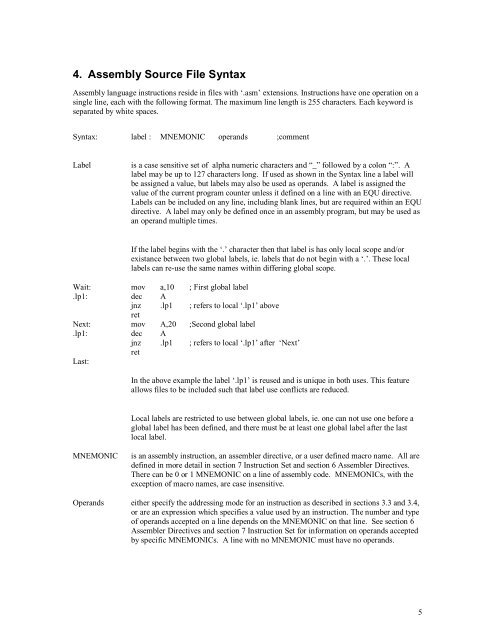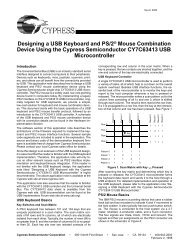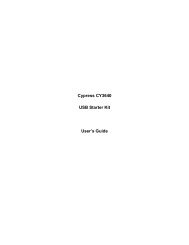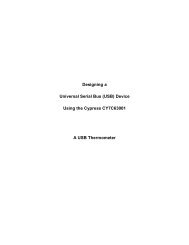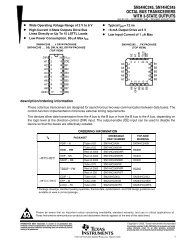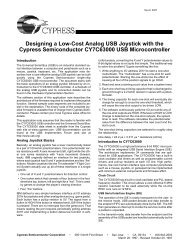CYASM ASSEMBLER USER'S GUIDE VERSION 1.77
CYASM ASSEMBLER USER'S GUIDE VERSION 1.77
CYASM ASSEMBLER USER'S GUIDE VERSION 1.77
You also want an ePaper? Increase the reach of your titles
YUMPU automatically turns print PDFs into web optimized ePapers that Google loves.
4. Assembly Source File Syntax<br />
Assembly language instructions reside in files with ‘.asm’ extensions. Instructions have one operation on a<br />
single line, each with the following format. The maximum line length is 255 characters. Each keyword is<br />
separated by white spaces.<br />
Syntax: label : MNEMONIC operands ;comment<br />
Label<br />
is a case sensitive set of alpha numeric characters and “_” followed by a colon “:”. A<br />
label may be up to 127 characters long. If used as shown in the Syntax line a label will<br />
be assigned a value, but labels may also be used as operands. A label is assigned the<br />
value of the current program counter unless it defined on a line with an EQU directive.<br />
Labels can be included on any line, including blank lines, but are required within an EQU<br />
directive. A label may only be defined once in an assembly program, but may be used as<br />
an operand multiple times.<br />
If the label begins with the ‘.’ character then that label is has only local scope and/or<br />
existance between two global labels, ie. labels that do not begin with a ‘.’. These local<br />
labels can re-use the same names within differing global scope.<br />
Wait: mov a,10 ; First global label<br />
.lp1: dec A<br />
jnz .lp1 ; refers to local ‘.lp1’ above<br />
ret<br />
Next: mov A,20 ;Second global label<br />
.lp1: dec A<br />
jnz .lp1 ; refers to local ‘.lp1’ after ‘Next’<br />
ret<br />
Last:<br />
In the above example the label ‘.lp1’ is reused and is unique in both uses. This feature<br />
allows files to be included such that label use conflicts are reduced.<br />
Local labels are restricted to use between global labels, ie. one can not use one before a<br />
global label has been defined, and there must be at least one global label after the last<br />
local label.<br />
MNEMONIC<br />
is an assembly instruction, an assembler directive, or a user defined macro name. All are<br />
defined in more detail in section 7 Instruction Set and section 6 Assembler Directives.<br />
There can be 0 or 1 MNEMONIC on a line of assembly code. MNEMONICs, with the<br />
exception of macro names, are case insensitive.<br />
Operands either specify the addressing mode for an instruction as described in sections 3.3 and 3.4,<br />
or are an expression which specifies a value used by an instruction. The number and type<br />
of operands accepted on a line depends on the MNEMONIC on that line. See section 6<br />
Assembler Directives and section 7 Instruction Set for information on operands accepted<br />
by specific MNEMONICs. A line with no MNEMONIC must have no operands.<br />
5


